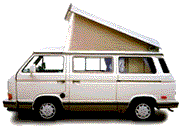Date: Tue, 28 Oct 1997 08:35:50 -0800
Reply-To: Mark McCulley <raven@HALCYON.COM>
Sender: Vanagon mailing list <Vanagon@Gerry.SDSC.EDU>
From: Mark McCulley <raven@HALCYON.COM>
Subject: Re: Charging Second Battery
Content-Type: text/plain; charset="us-ascii"
The aux battery relay closes whenever the alternator is producing voltage
(i.e. when the engine is running). When the relay closes, the aux battery
and the main battery are both connected to the regulated output of the
alternator. There is no circuitry that senses the charge level of the
batteries and adjusts the charging current or anything like that. The
battery that is the most discharged will take the bulk of the charging
current. The charging system in Vanagons, like all vehicles, is very basic
and not intelligent at all--but works fairly well.
You can buy a device (for a couple of hundred bucks) that will turn your
alternator into a smart charger that will do a better job of properly
charging your batteries. You can also buy intelligent converter/chargers
that will charge your batteries from shore power (120 VAC) as well as
provide 12 VDC when you're plugged into the grid (these units will often
handle multiple banks of batteries). I think the better investment is the
latter, a good converter/charger.
A 1.5 A trickle charger will not function as a converter (i.e. provide
enough 12 VDC) when you're at a campsite with power. The trickle charger
will keep your batteries charged, but will not do a good job of charging a
discharged aux battery. If you get a trickle charger, be sure it is
automatic and shuts off when the battery is charged.
I purchased a 10 Amp StatPower TrueCharge converter for my Westy. It is a
smart charger and will rapidly charge a discharged battery as well as supply
plenty of 12 VDC if needed. This way, I can fully recharge my aux battery
with a single nights stay at a campground with 120 VAC power. The best
source I've found for converter/chargers and similar battery-related devices
is marine supply stores (plenty of them here in Seattle).
-Mark McCulley
At 10:13 PM 10/27/97 -0800, Steven X. Schwenk wrote:
>Larry:
>
>Thanks for your reply. I am still confused....even after having read all i can
>find in the list. Here's what confuces me: I thought the #30 post on the
relay
>under the driver's seat was originally connected to the refridgerator, so that
>it only got power when the engine was runing, i.e., the alternator was
providing
>power. If you connect #30 to an aux battery, so that the aux battery is
charged
>by the alternator but isolated when the engine is off, what regulates whether
>the main or the aux battery gets charged? I thought #30 provided steady power
>to the refrigerator without interruption...so wouldn't it also do the same to
>the Aux battery? I am obviously missing something.
>
>Why did you instal a second relay?
>
>If these questions are too much a pain in the ... to aswer, i understand.
>
>Thanks!
>
>Steve
>
>Lawrence Johnson wrote:
>
>> Steven,
>> If I understand your description correctly, you have used the relay under
>> the driver's seat as a switching relay for charging the auxiliary battery.
>> If I am correct then it is similar to my setup except that I added a extra
>> relay for the job.
>> If my assumption is correct, then the relay will close only when the voltage
>> of the main (starting) battery equals the charging voltage from the
>> alternator; in other words, only when the main battery is charged. In this
>> case, the main battery will charge first, regardless of the size of the
>> auxiliary (camper) battery and only when the main battery is charged will
>> the auxiliary battery start to charge.
>> Larry
>> ~~~~~~~~~~~~~~~~~~
>> Steven X. Schwenk wrote:
>>
>> > <snip>When I installed the aux battery, I RAN a wire from the #30 post of
>> > the
>> > relay under the seat to the positive terminal of the battery so that the
>> > aux battery would charge while driving. <snip>
>
| 
